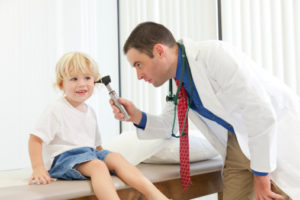
As an advice nurse at a busy pediatricians office, talking about ear infections (in medical lingo: otitis) is among one of the more frequent calls I deal with. I feel a pang for the stressed out, busy parent who would love to throw some magic medicine at the issue without an office visit. I know it is hard to take off time from work. Alas, it isn’t so simple.
Ear infections come in different varieties and complexities. Not only is there is not one standard treatment, but many times no treatment is even needed. Some stoic kids don’t make a noise about a severe infection while others complain bitterly about a little fluid in the ear that is not actually infected. If we blindly treated every complaint about an earache, we would be wildly over prescribing antibiotics. A special instrument that looks in the ear is often needed to make a true diagnosis. Factors like lots of ear wax or an uncooperative patient can add a level of complexity to the exam.
Common Ear Issues
Otitis media (a middle ear infection) Severe cases are treated with antibiotics.
Serous Otitis (fluid behind the eardrum) This may be treated with decongestants or in chronic cases with ear tubes.
Otitis externa (also known as swimmer’s ear) With otitis externa the outside of the ear is usually red and sore. The ears may be tender and will look inflamed. With summer coming, I usually see an increase in these cases, with more kids being in water or pools.
While the first two forms of otitis require a tool for diagnosis, otitis externa may be visible by just looking with the naked eye. This condition may be treated with ear drops rather than oral medications, depending on the severity.
Signs of Ear Infection
Some kids make it obvious. If they are old enough, they may simply tell you that their ear hurts. If they are still young and non-verbal, they may be extra fussy (especially when put down,) feverish, or tugging at their ear. Many kids wake up more than usual at night. Most of the time, kids are congested. Sometimes vomiting can be associated with ear infections.
Some kids seem like their balance is off. Others seem like they are having trouble hearing (I know, I know, all of our kids can seem deaf when we are telling them something they don’t care to hear!)
A good number of kids don’t let you know at all. We have had patients in the office for well child exams and have been caught by surprise when a routine ear check revealed a raging infection. I have also seen ear infections go from zero to sixty in no time flat— a child with a perfectly normal ear exam one day can have a horrible ear infection the next.
An important thing to note is that when kids have goopy eyes, many times they also have an ear infection, which is why we may bring them in to check out the eyes and the ears rather than just giving eye drops over the phone. Just because your child is tugging at their ear does not mean they have an infection. Some kids do it as a habit when they are tired, others do it when they are teething (especially upper teeth.) It can be a clue that is worth paying attention to, especially if it accompanies any other symptoms.
I realized after the fact that I had ignored my daughter Lauren’s first ear infection for more than a week when she was fairly young. Looking back at videos you can see the poor kid simply grabbing at her ear constantly. This was a long time ago, prior to my Noe Valley Pediatrics job, when I was working at UCSF with complicated surgical cases and thoughts of an ear infection didn’t even cross my mind.
Upper Respiratory Infections
Most of the time, an infection in the middle ear accompanies a common cold, the flu, or other types of respiratory infections. This is because the middle ear is connected to the upper respiratory tract by a tiny channel known as the eustachian tube. Germs that are growing in the nose or sinus cavities can climb up the eustachian tube and enter the middle ear. Children’s eustachian tubes are smaller and more level than those of an adult. This means it is harder for them to drain well and easier to get blocked up even with mild swelling.
Because of these drainage issues, when kids are congested, they also may have fluid in their ear (serous otitis). This is why I am more suspicious about a possible ear infection in a child who has a cold. What may start out as a virus can turn into something bacterial. That fluid is the perfect medium for bacteria to grow. I compare it to a stagnant pond just waiting for the mosquitoes to breed.
Treatment
If your child is diagnosed with an ear infection, chances are you will get a prescription for antibiotics. No one likes to overuse antibiotics, but if your child is miserable and feverish, I would follow through with the treatment.
If the eardrum is bulging and looks like the membrane may rupture, the doctor will advise you that you should absolutely go ahead with the medication regardless of how your child is acting. On the other hand, if it is not a severe infection and your child seems consolable, in our office we may suggest that it is perfectly fine to watch and see for a few days. Many ear infections can indeed clear up on their own, and of course, we all would like to avoid the use of antibiotics if we can.
If the treatment plan includes a course of antibiotics, make sure that you finish the entire course of medication. I also suggest using probiotics to protect the gut. Do not give them exactly in conjunction with the antibiotics, rather try to space them in between doses. Also please don’t forget to brush those teeth. Liquid antibiotics tend to be sticky and sweetened in order to make them more palatable.
Some pharmacies can add flavors that might help with compliance. The magic folks at the 450 Sutter pharmacy here in SF can compound some antibiotics into the form of savory crackers which have been a bit hit. If you are having trouble getting the “medicine to go down” My previous blog post offers some tips.
It may take the medication at least a couple of days before you notice a significant improvement. If your child is still super fussy or feverish after a full three days, have your doctor take another look in there to make sure the meds are working. Some kids who are having a really difficult time may end up getting an antibiotic injection. These hurt a bit, but they are usually quite effective.
Easing Discomfort
With or without the use of antibiotics there are several things you can do to ease the discomfort of a painful ear. Tylenol and/or Ibuprofen are useful. There are some prescription ear drops that can numb the ear, but they have some possible negative side effects, so most doctors no longer prescribe them.
Warmth usually feels good. Try a warm wet washcloth against the ear. You also can put some rice in a sock or pour water into a clean diaper, heat either of those up in a microwave to create a quick heat pad that will stay warm for a while. Heat in 30-second increments to make sure they don’t get too hot.
Some folks swear by a warm hair dryer held about a foot away from the ear. Believe it or not though, my favorite remedy is garlic oil. Check the ear to make sure there is no reason to suspect a rupture. I don’t like to add any drops if I have any suspicion that the eardrum may not be intact. If there is no odor or drainage (a little wax doesn’t count) garlic oil may be a good option. Saute some cloves of garlic in some olive oil. Let the oil cool until it is warm/not hot. Take a cosmetic square (these are the round or square cotton pads that often come in a stack. I like them better than cotton balls for this.) Dip one half of the pad into the oil, roll it up like a scroll and stick it in the ear. Do this as often as your child will allow.
If it is the middle of the night and your child is screaming, you can try any of these pain relief options until you have an opportunity to have your child checked. Persistent unrelenting misery may warrant a trip to the ER.
Ruptured Eardrum
My main agenda, aside from making the kids more comfortable, is preventing an eardrum from rupturing. This does happen and we can’t always stop it but we avoid it when we can. An eardrum that ruptures frequently can become scarred and this can lead to hearing loss.
A miserable screaming child might actually seem more comfortable after the eardrum finally ruptures. They will also likely have lots of yellow/orange stuff draining out of the ear. The good news is that the pain of the pressure in there is gone, but the tympanic membrane (an important protective barrier) is no longer intact. Therefore, if your child does have a ruptured membrane, they need to be seen and treated even though they are no longer quite as fussy. After a rupture (certainly if there is more than one) it is worthwhile getting the hearing tested to make sure there is no lingering hearing loss after the eardrum heals.
Chronic Ear Infections
Kids with chronic serous otitis who get one infection after another will usually end up at the ENT doctor who may put some tubes in the ear to help them drain. Melissa Wilson, Doctor of Audiology at Sound Speech and Hearing, adds that tubes are also put in to address the hearing loss that often accompanies middle ear fluid. Fluid build-up often causes a hearing loss on the order of 30-40 decibels. Average speech is about 60 decibels, so having fluid is like listening with your fingers plugging up your ears. Everything your child hears is muffled and over time; this can impact their speech and language development, and for the school-aged children, this can cause issues with listening in the classroom and academics.
Helpful Tools
For any interested parents, there is a product on the market called a Cellscope that allows you to visualize your child’s eardrum on your cell phone. The promo code NURSEJUDYNVP will get you 15% off your purchase. (I do not receive any compensation from CellScope; I just love helping families get a good deal!)
Just this week, a parent with a CellScope looked in there and found a little piece of a cereal puff. I told them that it’s better than the spider in a patient’s ear (honest to goodness) that one of our docs was surprised by last month!
Editor’s note: This article originally published on May 27, 2016, and was lightly edited prior to republishing.
[hr]

Judy Kivowitz has been known as Nurse Judy to her patients and families at Noe Valley Pediatrics in San Francisco, where she has been the advice nurse for almost 30 years. She has been attempting to transfer the assortment of wisdom stored inside her brain onto her blog, post by post.
She also offers an array of different classes to parents via www.nursejudy.com.
When you are a new parent, there is no such thing as a silly question!

















This is a great article, very informative! As a pediatrician, I would also add that while most otitis media is viral in origin, we will usually prescribe antibiotics in kids under 2 years old because due to their anatomy, younger kids are more susceptible to having bacteria spread to their blood stream, so antibiotics are used as an extra precaution. Thanks for sharing!!
Most people assume earaches and ear pain happen only to children, but they can also happen to adults. I read a lot of articles like https://www.everydayhealth.com/ear-pain/guide/ from Everydayhealth in order to understand my illness. An earache may affect one or both ears, but the majority of the time it’s in one ear. Ear pain may be dull, sharp, or burning, and it may feel constant or come and go. Pain in the ear can have multiple causes. It can be an early sign of colds, flu, or infection. If you have an ear infection, fever and temporary hearing loss may occur.